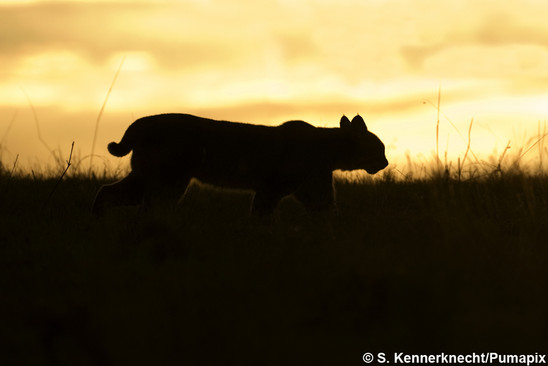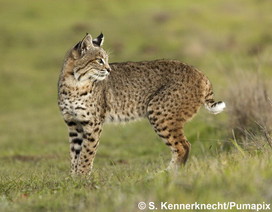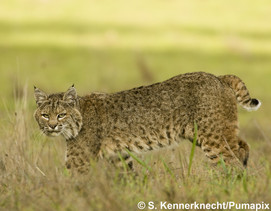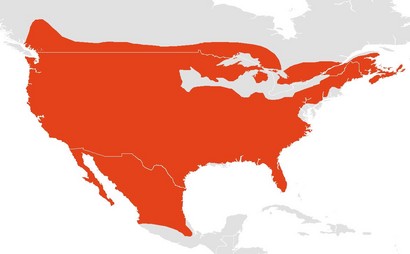Bobcat
Lynx rufus
IUCN Red List: Least Concern
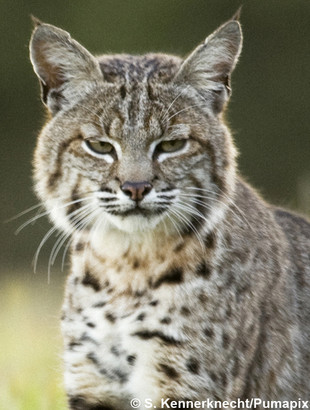
| Weight: | 6-20 kg |
| Body length: | 50-120 cm |
| Tail length: | 9-25 cm |
| Longevity: | 10-17 years |
| Litter size: | 1-8 cubs |
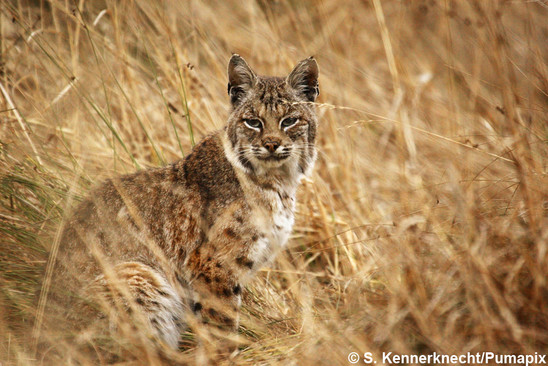
Description
The bobcat (Lynx rufus) is part of the genus Lynx and is closely related to the Canada lynx (Lynx Canadensis). Although 7-12 subspecies have been assumed from morphological characteristics, based on phylogeographic and genetic studies, currently two subspecies are recognised:
- Lynx rufus rufus East of the Great Plains, North America and
- Lynx rufus fasciatus West of the Great Plains, North America
However, the status of the bobcats in Mexico Lynx rufus esquinapae and Lynx rufus oaxacensis needs further clarification.
The bobcat is a medium-sized cat. It is named for its short tail which measures in average only 14 cm and is marked with black bars. The tail underside is white and not black coloured as in the other lynx species. The bobcat looks very similar to the Canada lynx but it has shorter ear tufts, shorter legs, smaller paws without heavily furred foot pads and a stockier appearance. Its head is small and wide surrounded by a ruff of fur. The bobcat’s fur is thick and soft and varies greatly in colour and patterns depending on the region. The coat colour can be tan, brown, yellowish brown, buff, reddish or pale grey; the pattern can be plain or with brown or black spots or stripes. The belly and underparts of the legs are light with dark markings. Melanistic individuals as well as albinos have been recorded. Males are 30-40% heavier than females and bobcats in the north of the range tend to be larger than in the sout
Language/Country | Name |
|---|---|
German | Rotluchs, Luchskatze |
Canada (French) | chat sauvage |
French | lynx roux |
Spanish | lince, lince rojo, gato montés |
Status and Distribution
The bobcat is classified as Least Concern in the IUCN Red List. It is the most common cat species in North America and is considered abundant. Densities of bobcats vary and are generally higher in the south of its range and lower in harsher environments. In Mexico, however, the densities are not high.
Country/Region | Density/100 km2 |
|---|---|
U.S. Arizona | 25 |
U.S. California | 57-62 |
U.S. California, southern | 25-42 |
U.S. Idaho | < 9 |
U.S. Illinois | 27-34 |
U.S. Texas | 48 |
U.S. Virginia | 11 |
Mexico, northwest | 25-30 |
Mexico | 5 |
The majority of the world’s bobcats are found in the United States. In 2010, wildlife biologists estimated the total U.S. bobcat population to range between 2.3 to 3.6 million animals, indicating that bobcat numbers increased considerably since the late 1990s. Bobcats inhabit all contiguous States in the U.S. except Delaware. Bobcat populations in the U.S. are now stable or increasing in at least 40 states with declines in only 1 state (Florida). The southeastern U.S. and the coastal regions of California appear to support the densest populations. Bobcat populations in the midwestern U.S. experienced historic declines due to habitat loss and exploitation but have rebounded considerably in recent decades. In Canada most bobcat populations are thought to be stable. Population trends in Mexico are not well known. In some areas of central Mexico the bobcat seems to be very rare.
The bobcat’s range extends from South Canada throughout the U.S. to north and central Mexico south to the state of Oaxaca. In the north its distribution is probably limited by deep snow and cold temperatures and in the south by interspecific competition with South American cat species. Towards the north bobcat range is expanding with forest clearing and general warmer climate.
Habitat
The bobcat uses a variety of different habitats but is more associated with woodlands than open areas. It inhabits boreal coniferous and mixed forests, upland and bottomland hardwood forest, coastal swamp, desert and scrubland. In the south, in Mexico, it occupies dry scrub and grassland as well as pine, oak and fir forests. The most important habitat requirements of a bobcat are enough food and cover for hunting and resting as well as sufficient shelter for den sites. The bobcat does not occur in intensively cultivated areas completely devoid of woody cover. Bobcats in New Hampshire and Vermont appear to prefer areas with few roads and low human impact. Generally, bobcats seem to prefer vegetative cover and water in regions away from roads. However, bobcats can also live in urban settings, with thriving populations in several U.S. cities such as Tucson, Arizona. The bobcat is generally found at low or mid-elevations. In the western U.S. however it has been recorded up to an elevation of 2,575 m and in western Mexico up to 3,500 m on the Colima Volcano.
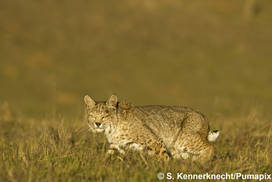
- Bobcat, California, USA.
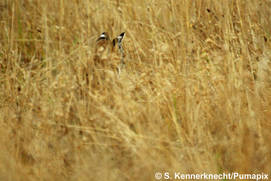
- Bobcat hidden in a field in California, USA.
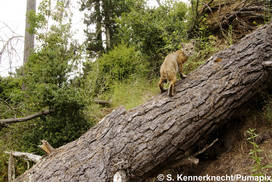
- Young bobcat, California, USA.
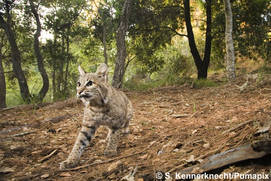
- Bobcat habitat, California, USA.
Ecology and Behaviour
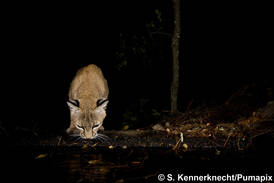
- Bobcat drinking water, California, USA.
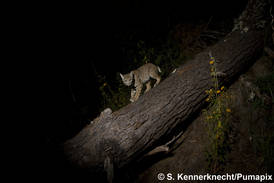
- Young bobcat on a fallen tree, California, USA.
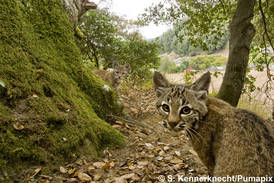
- Young bobcats, California, USA.
The bobcat is a solitary and primarily crepuscular species but depending on the environment it can also be active at day or night. For hunting the bobcat uses dense vegetation to ambush its prey. Bobcats live on the ground but are good climbers and flee into trees or even cactuses when threatened. Home range sizes are very variable and male home ranges are generally 2-3 times larger than female ones. Female home ranges in the U.S. range from 0.989-42.7 km² (mean 15.83 km²) and male home ranges from 2.86-167.9 km² (mean 39.7 km²). Territories of males mostly enclose those of several females but female territories are generally more exclusive, except in areas of higher densities. If an area has sufficient resources and if the population density is high, female ranges can also overlap. The bobcat marks its territory with urine, faeces, secretions from the anal glands and by scraping the ground to communicate with other bobcats.
In the north of its range in northern U.S. and southern Canada the bobcat shares its habitat with the Canada lynx (Lynx canadensis). In areas where both species coexist, the more aggressive bobcat usually displaces the Canada lynx. Recent evidence suggests that bobcats can coexist with other carnivores such as coyotes (Canis latrans) and pumas (Puma concolor) in areas of relatively high prey availability.
The breeding peak of the bobcat is in late winter (Feb-Mar). Most births take place in the early spring (Apr-May), but in the south of its range births could be observed throughout the whole year. Estrus lasts for 5-10 days, the estrus cycle for approximately 44 days and the gestation period for 50-70 days. Younger females seem to have smaller litter sizes than older ones. Males reach sexual maturity at around 1.5 years and females at 9-12 months but sometimes may not breed until their second year. The pregnancy rates for adults (>3 years) are much higher. The interbirth interval is generally one year. Cubs stay with their mother up to one year. In search of a territory one young male bobcat was documented to have moved up to 200 km, and genetic evidence supports long-distance dispersal by juvenile male bobcats. In exploited populations annual adult survival is reduced and is estimated to range from 49-67%. In general harvest mortality is greatest among the yearling and 1-2 year old young adult age classes. Annual survival in unharvested populations can be as high as 84%.
Prey
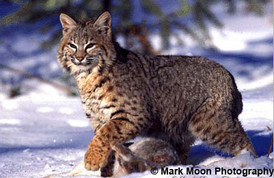
- Bobcat with a killed hare.
The diet of the bobcat is broad. In most areas its major prey are rabbits and hares but the bobcat also takes small rodents, rats, squirrels, chipmunks, beavers, birds, opossums, peccaries and occasionally small ungulates such as white-tailed deer. Bobcats seem to switch prey seasonally depending on their availability. In the north of its range ungulates even can be an important winter food source since with deep snow the vulnerability of ungulates to predation rises. The bobcat also scavenges carcasses of other predators and if there is a shortage in prey density the bobcat may even depend on carrion. The prey of the bobcat mostly weighs less than 3 kg but can be much heavier. Several studies have found that males tend to consume larger prey than females and juveniles consume proportionally more rodents and carrion than adults.
Main Threats
Habitat loss through human activity is considered the main threat to the bobcat throughout its range. Bobcat show a certain adaptability to urbanization. However, in urban landscapes the number of road accidents is higher and there is a higher exposure to rodenticides and increased susceptibility to notoedric mange which can result in higher mortality. Urbanization and road constructions can also result in genetic isolation of bobcat populations. In Mexico, the bobcats' habitat especially suffers from degradation and alteration. In localized areas, the bobcat is persecuted as a pest due to occasional livestock predation.
Bobcats get killed by mountain lions and hybridization with Canada lynx has been detected in Maine, Minnesota and New Brunswick. In southern Florida, bobcat observations highly decreased with the increase of invasive pythons. The spread of diseases such as canine distemper from domestic dogs to bobcats is of concern.
The demand for bobcat fur increased gradually and then decreased sharply in the mid-1970s when CITES came into force and pelts of cats listed in Appendix I became legally unobtainable for the commercial trade. The coat of the bobcat is the most common one on the international market and the bobcat is the most heavily harvested cat species. From 2000-2006 the average number of bobcat furs sold was 29,772. Most furs were exported from the U.S. in 2006 when 51,419 pelts were traded. Each year around 20,000 - 40,000 bobcats are legally hunted for the market. This seems so far to be sustainable and the U.S. government considers the trade to be well managed and not detrimental to bobcat survival. However, bobcat populations in some areas are not monitored adequately with population size and density estimates generally missing. Moreover, in recent years the fur prices increased from $85 in 2000 to $589 in 2013, $447 in 2014 to $305 in 2015 due to the high fur demand in China, Europe and Russia, which is of concern. The number of exported bobcat furs from the U.S. increased to 65,000 in 2013.
Conservation Efforts and Protection Status
The bobcat is included in Appendix II of CITES. Hunting and trade of the bobcat is regulated throughout its range. It is legally harvested in 38 US states and 7 Canadian provinces. The bobcat is not protected in Canada and in Mexico hunting is regulated in five states. In Mexico shooting of bobcats suspected to have killed livestock is permitted on a limited basis and it is hunted as a trophy animal in small numbers. There appears to be little illegal international trade.
The bobcat is a popular game animal and in recent years demand for bobcat fur has increased. Therefore, it is important to closely monitor the trade and bobcat populations. The bobcat is the subject of many research studies and one of the most studied cat species in the world. Nevertheless, the population of Mexico is not well known and there is still concern over whether commercial trapping is sustainable. The bobcat monitoring is still not satisfactory in all parts of its range. Further research on bobcat distribution, abundance, and habitat relationships are important research needs and an effective monitoring in all parts of the bobcat’s range is needed to be able to adequately control harvest activities and determine their sustainability.
In Georgia and New Jersey bobcats were successfully reintroduced. There were petitions for removing the bobcat from the CITES Appendices with the arguments that the bobcat does not meet the biological criteria for CITES anymore and that skins of bobcats could be reliably distinguished from other furs. However, the proposal was rejected and the bobcat is still included in Appendix II of CITES.
